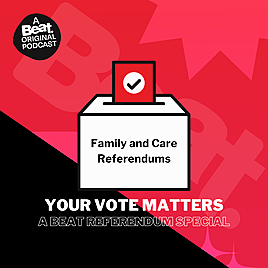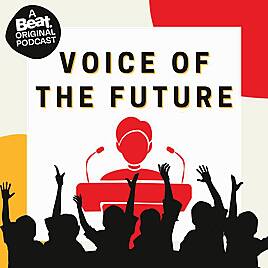
The British Are Charting Edition Part 2
28 April 2023 - 54 minsBefore 1964, British bands couldn’t get anywhere on the U.S. charts. Then suddenly, after a certain Fab Four broke, they were everywhere. By 1965, they had locked down our Top 10.
In 1981, a new generation of U.K. acts armed with synthesizers were largely shut out of the Hot 100 once again. But then a new video channel called MTV changed the game—helped by some very pretty men in dapper suits. By 1983, half of the U.S. Top 40 had a British accent.
What did these two movements have in common, besides screaming fans and impressive hair? Join Chris Molanphy as he dissects these two bloodless coups that rebooted our hit parade. These Invasions were about as easy as a nuclear war.
Podcast prod...

Mighty Real Edition Part 2
Little Richard was rock ‘n’ roll’s flamboyant architect. Lesley Gore sang that no one owned her. Sylvester was a gender-fluid icon who helped define disco. Freddie Mercury made rock operatic, and George Michael demanded freedom. What all of these LGBTQ artists had in common was bold hitmaking—and fear of being fully out of the closet. For decades, queer acts topped the charts while cloaking their true identities and paving the way for today’s more openly queer stars. For Pride Month, join Chris Molanphy as he traces the hidden history of queer hitmakers on the charts—including those that managed to be both out and No. 1, right up through our modern age of Lil Nas X and Chappell Roan. It’s a celebration of these artists’ quest to feel… mighty real. Get more Hit Parade with Slate Plus! Join for monthly early-access episodes, bonus episodes of "The Bridge," and ad-free listening across all your favorite Slate podcasts. Subscribe directly from the Hit Parade show page on Apple Podcasts or Spotify. Or, visit slate.com/hitparadeplus to get access wherever you listen. Learn more about your ad choices. Visit megaphone.fm/adchoices
1 hour 5 mins
27 June Finished

Mighty Real Edition Part 1
Little Richard was rock ‘n’ roll’s flamboyant architect. Lesley Gore sang that no one owned her. Sylvester was a gender-fluid icon who helped define disco. Freddie Mercury made rock operatic, and George Michael demanded freedom. What all of these LGBTQ artists had in common was bold hitmaking—and fear of being fully out of the closet. For decades, queer acts topped the charts while cloaking their true identities and paving the way for today’s more openly queer stars. For Pride Month, join Chris Molanphy as he traces the hidden history of queer hitmakers on the charts—including those that managed to be both out and No. 1, right up through our modern age of Lil Nas X and Chappell Roan. It’s a celebration of these artists’ quest to feel… mighty real. Get more Hit Parade with Slate Plus! Join for monthly early-access episodes, bonus episodes of "The Bridge," and ad-free listening across all your favorite Slate podcasts. Subscribe directly from the Hit Parade show page on Apple Podcasts or Spotify. Or, visit slate.com/hitparadeplus to get access wherever you listen. Learn more about your ad choices. Visit megaphone.fm/adchoices
1 hour 3 mins
13 June Finished

All Apologies Edition Part 2
The story of Nevermind, Nirvana’s genre-defining breakthrough, is a familiar one. Less well known is the saga of Billboard’s Modern Rock chart—and how college-rock staples of the 1980s like R.E.M. and The Cure gave way to heavier, more commercially dominant groups of the ‘90s like Soundgarden, Alice in Chains, Pearl Jam, and The Smashing Pumpkins. What sparked the grungification of the charts? How did Modern Rock become the new Top 40? And how did the Seattle sound pave the way for post-grunge bands like Sublime, Third Eye Blind, and even Creed? Join Chris Molanphy as he explores alternative rock’s evolution from the cutting edge to the middle of the road. Podcast production by Olivia Briley and Kevin Bendis Learn more about your ad choices. Visit megaphone.fm/adchoices
1 hour 3 mins
30 May Finished

All Apologies Edition Part 1
The story of Nevermind, Nirvana’s genre-defining breakthrough, is a familiar one. Less well known is the saga of Billboard’s Modern Rock chart—and how college-rock staples of the 1980s like R.E.M. and The Cure gave way to heavier, more commercially dominant groups of the ‘90s like Soundgarden, Alice in Chains, Pearl Jam, and The Smashing Pumpkins. What sparked the grungification of the charts? How did Modern Rock become the new Top 40? And how did the Seattle sound pave the way for post-grunge bands like Sublime, Third Eye Blind, and even Creed? Join Chris Molanphy as he explores alternative rock’s evolution from the cutting edge to the middle of the road. Podcast production by Olivia Briley and Kevin Bendis. Learn more about your ad choices. Visit megaphone.fm/adchoices
1 hour 8 mins
17 May Finished

Only Girl in the World Edition Part 2
It’s been nearly a decade since Rihanna released a studio album—and fans and critics alike have wondered when, if ever, a follow-up to 2016’s Anti might arrive. Which is ironic, because in her heyday, Rihanna was the most productive hitmaker on the charts. Churning out at least one album a year in the late aughts and early ‘10s, Rihanna’s approach to the charts was closer to early Motown or the Beatles than Beyoncé or Taylor. The result: the Barbadian pop deity scored more No. 1s than any 21st century artist, from “SOS” and “Umbrella” through “Diamonds” and “Work.” Join Chris Molanphy as he traces Rihanna’s journey from tropical tyro to commanding chart queen and explores how she found hits at a boundless pace. Podcast production by Kevin Bendis. Learn more about your ad choices. Visit megaphone.fm/adchoices
58 mins
25 April Finished

Only Girl in the World Edition Part 1
It’s been nearly a decade since Rihanna released a studio album—and fans and critics alike have wondered when, if ever, a follow-up to 2016’s Anti might arrive. Which is ironic, because in her heyday, Rihanna was the most productive hitmaker on the charts. Churning out at least one album a year in the late aughts and early ‘10s, Rihanna’s approach to the charts was closer to early Motown or the Beatles than Beyoncé or Taylor. The result: the Barbadian pop deity scored more No. 1s than any 21st century artist, from “SOS” and “Umbrella” through “Diamonds” and “Work.” Join Chris Molanphy as he traces Rihanna’s journey from tropical tyro to commanding chart queen and explores how she found hits at a boundless pace. Podcast production by Kevin Bendis. Learn more about your ad choices. Visit megaphone.fm/adchoices
1 hour
11 April Finished





















